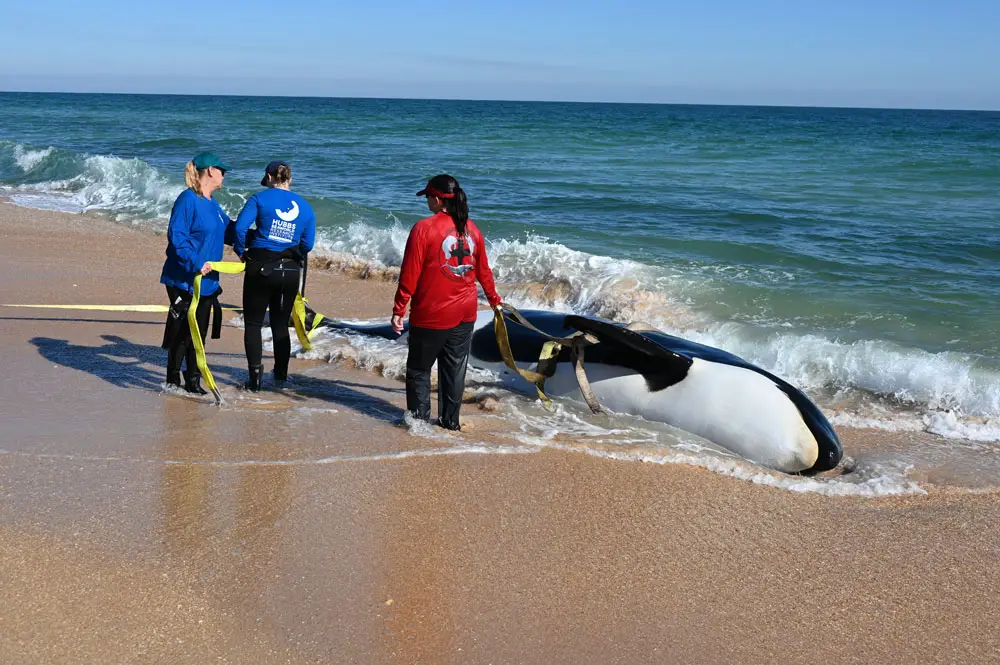
Last Updated: 6:29 p.m.
A killer whale was found beached at dawn this morning in the surf opposite Hammock Dunes Club. The young female orca was dead, but a NOAA officials confirmed that the whale may have been alive when it was initially spotted.
A visitor walking along the beach at 6:30 this morning discovered the whale and called authorities, almost 10 years to the day when a 26-foot right whale was found beached just south of Varn Park. That whale had also died.
Killer whales, or orcas, range in all five oceans, but it is the first time an orca has beached in Flagler—or anywhere in the Southeast United States. The singularity of the event is heightening marine biologists’ questions and will draw even more particular interest from scientists than other documented beached-whale occurrences of the season, none involving an orca.
Saturday, a stranded fin whale was reported in Mississippi, that state’s first ever, and only the fourth such occurrence in 20 years in the Gulf of Mexico.
The whale in Flagler was measured at 21.3 feet, with an early estimate of 5,000 to 6,000 pounds.
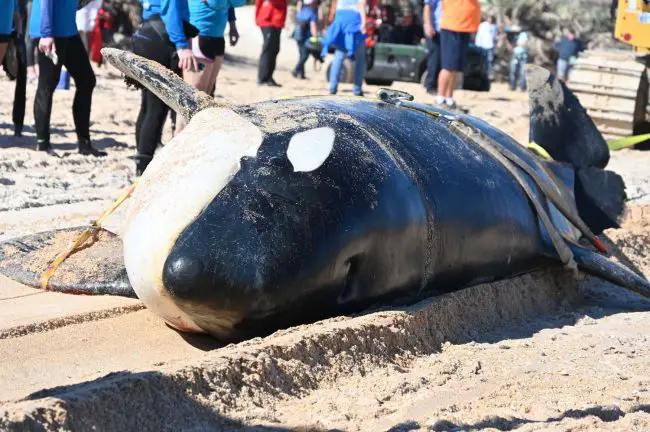
“This appears to be an adult female,” Blair Mase, NOAA’s Southeast Region Marine Mammal Stranding Coordinator, said. “She’s in decent body condition. So we have veterinarians and pathologists and biologists waiting to conduct a necropsy, which is an autopsy on an animal for this animal to try to determine the cause of death.” Mase cited video showing the whale alive around 6 a.m. The orca may have been bruised by shallow rocks in the surf that have emerged since the severe erosion of the shore since last year.
Mase underscored how unusual it was to have a beached orca, when even sightings are rare. “We do have orca sightings recorded off on the Gulf Stream, the Atlantic Coast as well as the Gulf of Mexico,” she said. “We have two known stocks, one in Atlantic and one in the Gulf, but we’ve never had a stranding. So that’s what’s so unusual. We’ve never actually had one beach itself. So this is extremely rare and our job is to find out potential cause of death and get as much information as possible from this animal.”
Strandings are not uncommon, but are still not well understood: why whales beach themselves largely remains a mystery. Last October 477 pilot whales died in a massive stranding on an isolated New Zealand beach. Weeks earlier, 230 whales were stranded in Tasmania, the Australian island. Dozens were rescued, but many died.
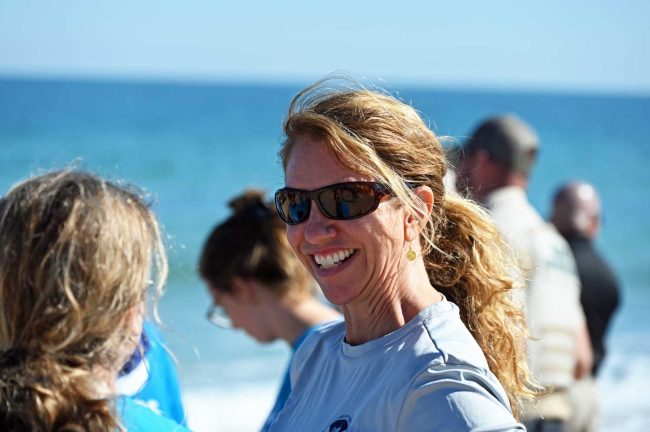
“Our job is to try to find out why it died and what is the potential cause of death,” Mase said of the orca, a few dozen feet from the animal. “We won’t really know if it’s something natural or a potentially anthropogenic human cause, that’s our job, is to kind of rule things in or out. Then at that point, we can determine if there’s cause for concern.” It’ll take weeks before results are in, sometimes months for a full analysis.
Climate change has been on Mase’s mind. “We are starting to see unusual species that we don’t typically see here in the southeast, appearing more and more in sightings and in stranding,” she said. But many reasons have been attributed to strandings, she said, from disease in the animal, to human effects such as sonar, “noise that could impact their equilibrium,” and so on.
The whale’s black and white skin was glimmering in the surf, wave after wave striking against it as a team of workers and volunteers from various agencies held it in place with ropes around mid-morning. They were preparing to transfer it to a trailer, already at the scene, for transport to SeaWorld in Orlando for a necropsy.
The removal operation began around 11:15 with first one Bobcat, then a second, brought in to pull the whale out of the surf as a dozen people soaked to the chest pushed the whale from behind. Helicopters, including Flagler County FireFlight at one point, then a Coast Guard plane and drones, whirred overhead.

But the operation was proving more challenging than expected. Some 40 minutes into the operation, the teams had rolled the whale into a sort of gurney that would ease the transfer out of the sands by minimizing stresses on the whale’s body.
Pulling the gurney up through the slope of 25-30 yards of sand was the next challenge. One of the Bobcats desisted, replaced by a more earnestly massive bulldozer. The whale’s gurney was attached to the bulldozer’s blade.
Then, with 16 people holding and pushing the gurney and both Bobcat and bulldozer’s engines revving as they slowly inched back, the enormous, eternally slumbering animal began her final trek out of her sea. With the crowd all around, hushed but for the wails of the dozers, it wasn’t much different from a funeral march: the expression on many faces, somber even in sunshine—-the crestfallen expression on the face of Steve Williams, the Flagler County Sheriff’s agriculture deputy who’s known his share of tragic animal revues and belated finds, or on the faces of tourists who’d expected a different morning, but not that different—reflected the sadness of the occasion.
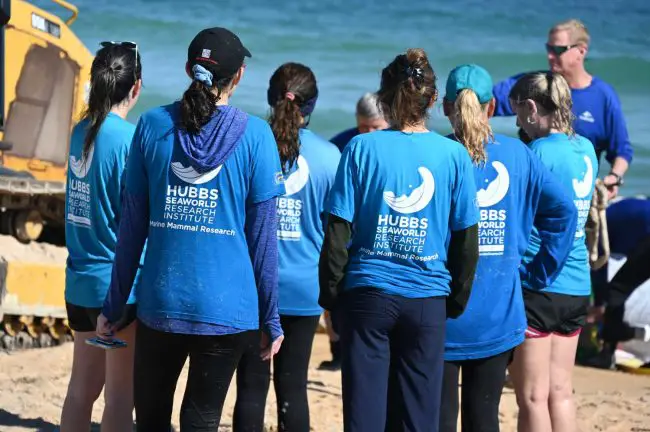
A little further out of the surf, the gurney now enveloped the killer whale almost entirely, shroud-like, freeing those who’d been pushing the animal from behind to come out of the surf. The rest would be up to the dozers, their reverse’s beep-beeping warning tolling. At least that’s what it looked like until just after noon, when the effort seemed to come to a halt. Some regrouping was in order.
Blair Mase, NOAA’s Southeast Region Marine Mammal Stranding Coordinator, confirmed that there was an issue: some of the stretcher’s components had severed. That would require the team to find a different way of bringing the whale to the trailer.
At 12:30 p.m., all was at a standstill as teams devised a different approach.
The decision, by close to 1 p.m., was this: straps would wrap around the whale’s tail. The bulldozer would pull and slide it along the wet portion of sands, north, the quarter-mile distance to Jungle Hut Road, where the trailer would be waiting. So it was. The dozer pulled the whale about 300 yards, but then the team opted to add more straps, so as to lift her fins off the sand. Then the procession resumed, a smaller swarm of mourners following.
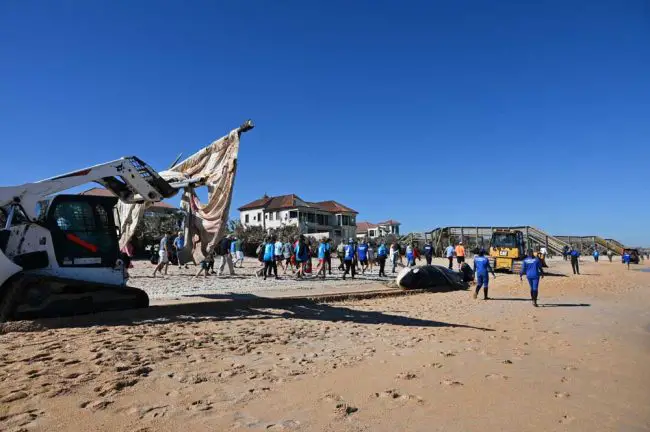
On the other side of the dune line, or what’s left of it, by the Jungle Hut Road bathrooms, Flagler County Public Works and general services crews—among the yeomen of the operation—staged trucks to reclaim the dozers, and prepared mounds of ice that would surround the whale on a SeaWorld flatbed, on her way to Orlando.
The whale arrived at SeaWorld in Orlando just after 6 p.m.
The Flagler County Sheriff’s Office early this morning had roped a large square area around the whale as crowds began forming soon after the Sheriff’s Office had posted on Facebook about the discovery. The agency later took down the posting at the request of authorities at the scene so as to minimize the number of people who might swarm to the beach, and blocked access to Jungle Hut park. At midday, some 75 to 100 people were milled around the yellow tape, cell phone cameras clicking.
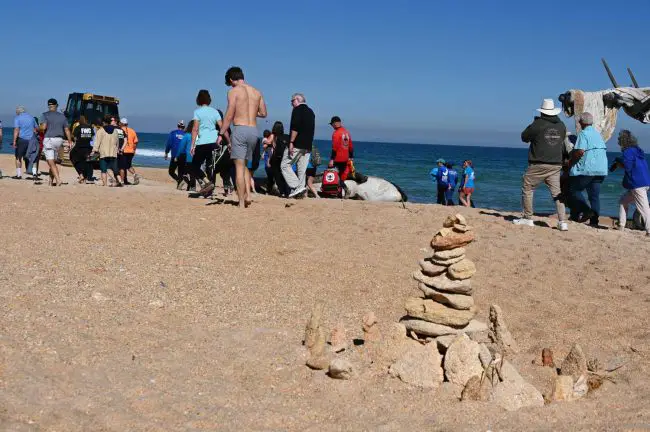
Authorities, scientists and volunteers at the scene included members of the Florida Fish and Wildlife Conservation Commission, the National Oceanic and Atmospheric Administration, SeaWorld, and Hubbs Seaworld, an organization that partners with SeaWorld.
Little information was known about the circumstances that led to the beached whale: it is extremely unusual for killer whales to venture so close to shore. They are seldom spotted, even alive. Some six or seven years ago in Flagler, Danielle Wiegel, a volunteer with Hubbs Seaworld said, “a surfer swore he saw one but no one believed him.”
Earlier this week, right whales were spotted offshore in Flagler.
![]()




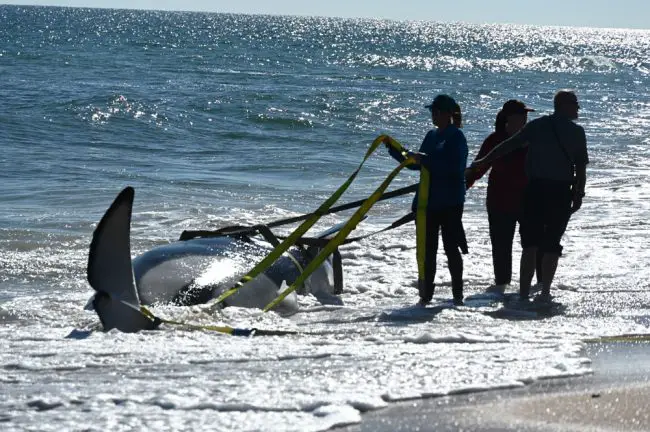
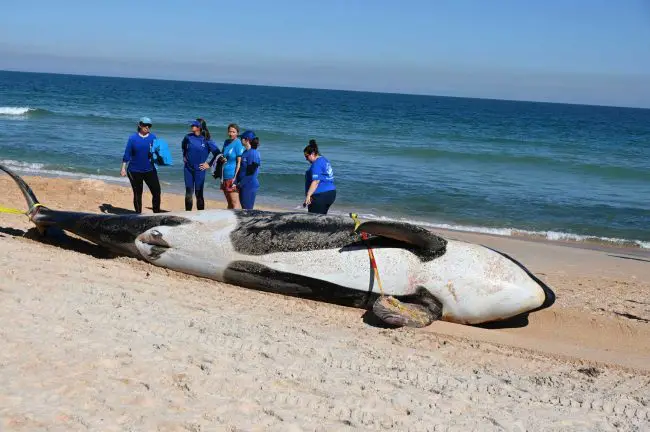
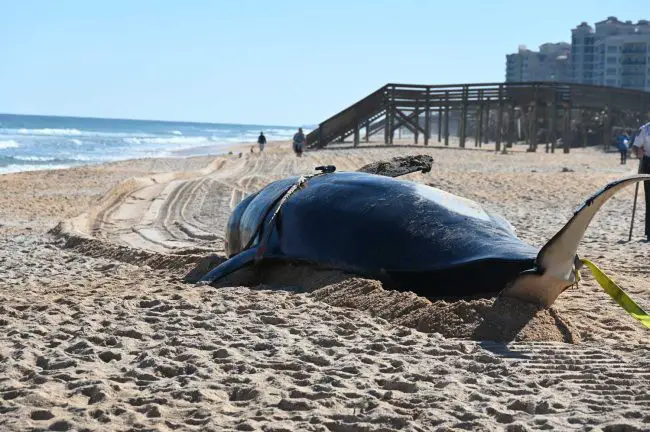
























Carol says
Very very sad.
MeToo says
Can’t stay off social media….SMH
Heartbreaking says
So heartbreaking. Such beautiful mammals. Such a sad event.
Deborah Coffey says
Makes you want to cry. Godspeed mama whale.
Atwp says
Is whale beaching a natural process?
Gina Weiss says
I’ll just leave this right here:
http://www.youtube.com/watch?v=2b4CYxcxSds
Sad says
I just heard on the news 5 whales have been beached in the last month up north, due to NJ installing wind mills in the water and whales are getting confused because they work on sonar. This might be related. Is a problem.
Janet Sullivan says
Great photos, FlaglerLive. Thank you.
Very Upset says
Has to be due to climate change. This has to end. We need to stop the use of gas and oil by the end of the year. Those damn MAGA people have blood on their hands.
FREE WILLY says
This is caused by those bastard Wind Turbine engineers off the coast up around New Jersy, injecting Sonar frequency waves into the bottom to find the right spots for their 1000’s of Wind Turpines they are about to build up there. It messes up the Whales brain. Just yesterday 6 other Whales beached themselves on the Jersey beaches….. Its disgusting !!!!
Orcas for silence says
This is sad, but if I couldn’t escape the sound of flight schools vibrating my water all day and night, I’d probably beach myself too. R.I.P. Orca.
Larry hochstetler says
It so sad to see this they are such beautiful mammals my heart goes the whale 🐋 God bless them Larry
Laurel says
Okay, for starters, Orcas are not whales, they are dolphins. This particular dolphin was ill and old. When a dolphin, or a whale, is ill, it has great difficulty in using the energy to keep itself buoyant for breathing, hence, beaching itself.
Now, as far as feeling sad about dolphins becoming hurt, I’m not seeing that when I see boats hauling ass up and down the ICW’s narrow channels without any regard for the wildlife. If you really care, turn off the blasting music and keep your eyes open to your surroundings.
Gina Weiss says
Laurel: I agree with you when speed boats do not obey the slow down speed limits of sensitive areas because some selfish people want to feel the wind blow through their hair. Also just to clarify dolphins are whales and are a part of the whale family, collectively whales, dolphins, and porpoises are called cetaceans.
http://www.ifaw.org/uk/journal/are-dolphins-whales
Laurel says
Gina: I will concede – partially. Both tomatoes and eggplants are nightshades, yet a tomato is a tomato, and an eggplant is an eggplant. Pigeons are doves, yet we call a pigeon a pigeon, and a dove a dove. By that logic, a dolphin is a dolphin and a whale is a whale! Most people think an Orca is a whale, and have no idea it’s a dolphin, which has distinct differences of behavior, ability and feeding patterns.
My friend in Wisconsin was mortified when she read that we caught and ate dolphins, which are now referred to Mahi-mahi. Once she understood, she was greatly relieved!
However, you are correct and I appreciate the info! :)